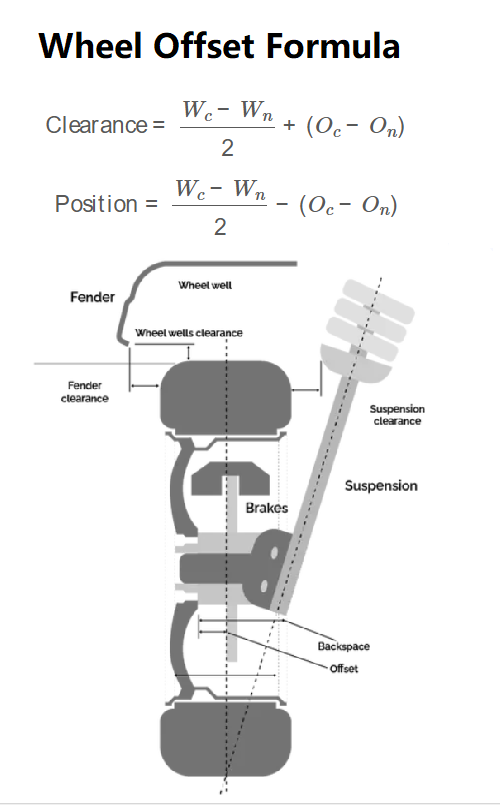1. What is a Wheel Offset Calculator?
Definition: This calculator determines the change in clearance and position of a vehicle’s wheel when switching to a new wheel with different width and offset.
Purpose: It helps automotive enthusiasts and mechanics ensure that a new wheel will fit properly without interfering with the suspension or body, ensuring safety and performance.
2. How Does the Calculator Work?
The calculator uses the following formulas:
Change in Clearance:
\[
\text{Clearance} = \frac{W_c - W_n}{2} + (O_c - O_n)
\]
Change in Position:
\[
\text{Position} = \frac{W_c - W_n}{2} - (O_c - O_n)
\]
Where:
- \( W_c \): Width of the current wheel
- \( W_n \): Width of the new wheel
- \( O_c \): Offset of the current wheel
- \( O_n \): Offset of the new wheel
Unit Conversions:
- Width and Offset:
- 1 mm = 0.1 cm
- 1 mm = 0.0393701 in
- 1 mm = 0.00328084 ft
Steps:
- Enter the width and offset of the current wheel, selecting the unit (mm, cm, in, ft) for each.
- Enter the width and offset of the new wheel, selecting the unit for each.
- Convert all measurements to mm for calculation.
- Calculate the change in clearance and position using the formulas.
- Display the results in the selected output units, with the ability to change units independently.
3. Importance of Wheel Offset Calculation
Calculating wheel offset changes is crucial for:
- Safety: Ensuring the new wheel does not interfere with the suspension or bodywork.
- Performance: Maintaining proper wheel alignment and handling.
- Aesthetics: Achieving the desired stance by adjusting wheel position.
4. Using the Calculator
Examples:
- Example 1: For \(\text{Current Width} = 200 \, \text{mm}\), \(\text{Current Offset} = 40 \, \text{mm}\), \(\text{New Width} = 220 \, \text{mm}\), \(\text{New Offset} = 35 \, \text{mm}\):
- Change in Clearance: \(\text{Clearance} = \frac{200 - 220}{2} + (40 - 35) = -10 + 5 = -5 \, \text{mm}\)
- Change in Position: \(\text{Position} = \frac{200 - 220}{2} - (40 - 35) = -10 - 5 = -15 \, \text{mm}\)
- In inches: \(\text{Clearance} = -5 \div 25.4 = -0.20 \, \text{in}\), \(\text{Position} = -15 \div 25.4 = -0.59 \, \text{in}\)
- Interpretation: The new wheel is 0.20 inches closer to the suspension and 0.59 inches more inward.
- Example 2: For \(\text{Current Width} = 8 \, \text{inches}\), \(\text{Current Offset} = 1.5 \, \text{inches}\), \(\text{New Width} = 9 \, \text{inches}\), \(\text{New Offset} = 1.2 \, \text{inches}\):
- Convert: \(\text{Current Width (mm)} = 8 \times 25.4 = 203.2 \, \text{mm}\), \(\text{Current Offset (mm)} = 1.5 \times 25.4 = 38.1 \, \text{mm}\), \(\text{New Width (mm)} = 9 \times 25.4 = 228.6 \, \text{mm}\), \(\text{New Offset (mm)} = 1.2 \times 25.4 = 30.48 \, \text{mm}\)
- Change in Clearance: \(\text{Clearance} = \frac{203.2 - 228.6}{2} + (38.1 - 30.48) = -12.7 + 7.62 = -5.08 \, \text{mm}\)
- Change in Position: \(\text{Position} = \frac{203.2 - 228.6}{2} - (38.1 - 30.48) = -12.7 - 7.62 = -20.32 \, \text{mm}\)
- In inches: \(\text{Clearance} = -5.08 \div 25.4 = -0.20 \, \text{in}\), \(\text{Position} = -20.32 \div 25.4 = -0.80 \, \text{in}\)
- Interpretation: The new wheel is 0.20 inches closer to the suspension and 0.80 inches more inward.
5. Frequently Asked Questions (FAQ)
Q: What does a negative clearance mean?
A: A negative clearance means the new wheel is closer to the suspension, potentially causing interference.
Q: What does a positive position mean?
A: A positive position means the new wheel is more outward relative to the vehicle’s suspension.
Q: How accurate is the calculation?
A: The calculation is accurate for the given inputs but does not account for real-world factors like suspension geometry or wheel well constraints.
Wheel Offset Calculator© - All Rights Reserved 2025
 Home
Home
 Back
Back
